stop start FIAT LINEA 2007 1.G User Guide
[x] Cancel search | Manufacturer: FIAT, Model Year: 2007, Model line: LINEA, Model: FIAT LINEA 2007 1.GPages: 230, PDF Size: 3.31 MB
Page 123 of 230
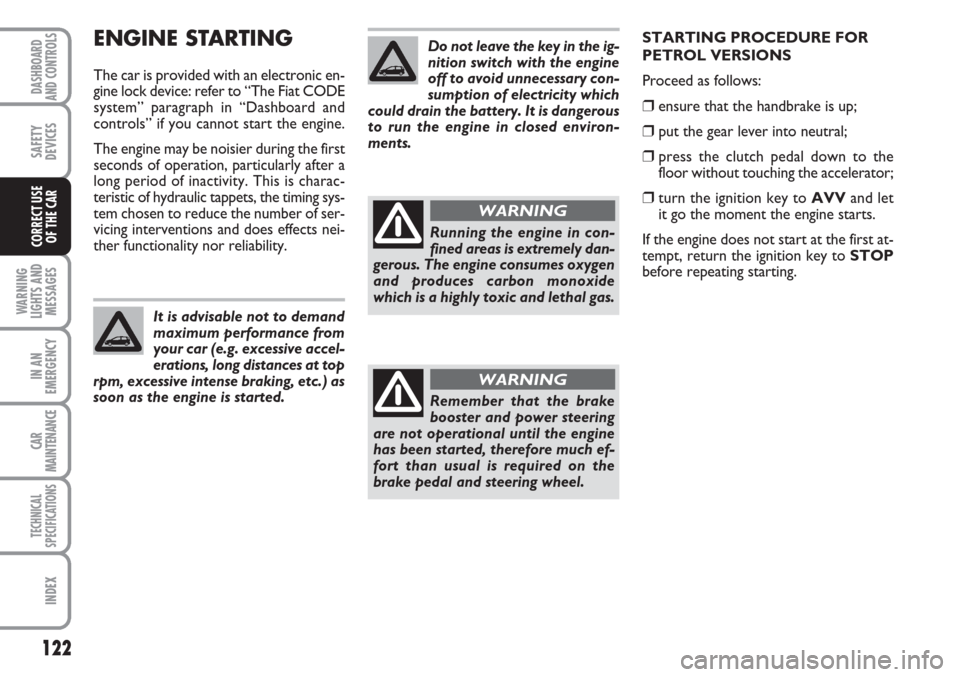
122
WARNING
LIGHTS AND
MESSAGES
IN AN
EMERGENCY
CAR
MAINTENANCE
TECHNICAL
SPECIFICATIONS
INDEX
DASHBOARD
AND CONTROLS
SAFETY
DEVICES
CORRECT USE
OF THE CAR
ENGINE STARTING
The car is provided with an electronic en-
gine lock device: refer to “The Fiat CODE
system” paragraph in “Dashboard and
controls” if you cannot start the engine.
The engine may be noisier during the first
seconds of operation, particularly after a
long period of inactivity. This is charac-
teristic of hydraulic tappets, the timing sys-
tem chosen to reduce the number of ser-
vicing interventions and does effects nei-
ther functionality nor reliability.
It is advisable not to demand
maximum performance from
your car (e.g. excessive accel-
erations, long distances at top
rpm, excessive intense braking, etc.) as
soon as the engine is started.
Do not leave the key in the ig-
nition switch with the engine
off to avoid unnecessary con-
sumption of electricity which
could drain the battery. It is dangerous
to run the engine in closed environ-
ments.
Running the engine in con-
fined areas is extremely dan-
gerous. The engine consumes oxygen
and produces carbon monoxide
which is a highly toxic and lethal gas.
WARNING
Remember that the brake
booster and power steering
are not operational until the engine
has been started, therefore much ef-
fort than usual is required on the
brake pedal and steering wheel.
WARNING
STARTING PROCEDURE FOR
PETROL VERSIONS
Proceed as follows:
❒ensure that the handbrake is up;
❒put the gear lever into neutral;
❒press the clutch pedal down to the
floor without touching the accelerator;
❒turn the ignition key to AVVand let
it go the moment the engine starts.
If the engine does not start at the first at-
tempt, return the ignition key to STOP
before repeating starting.
Page 124 of 230
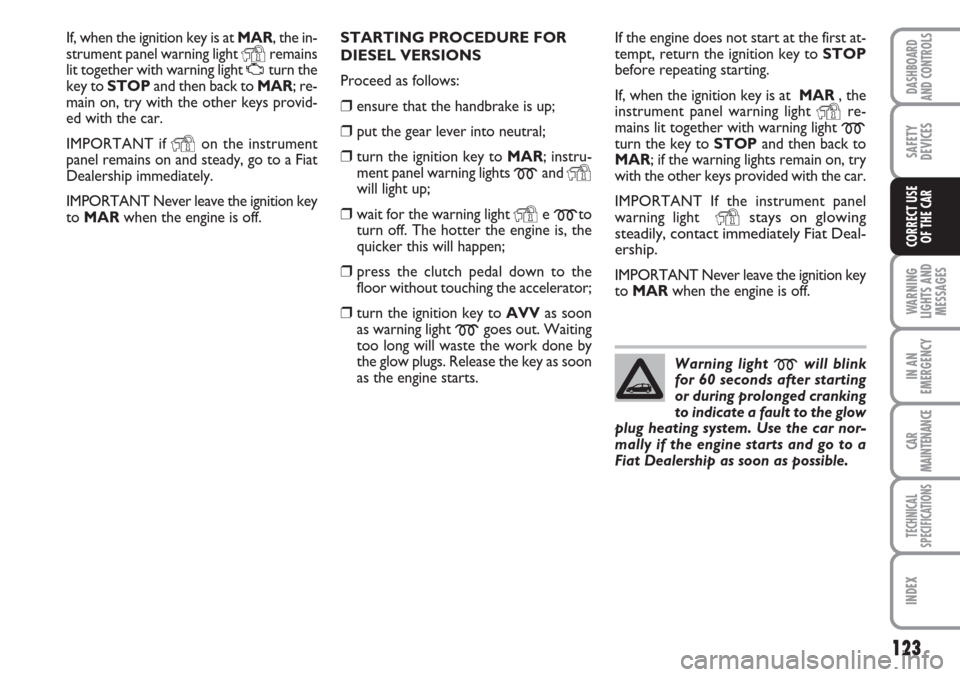
123
WARNING
LIGHTS AND
MESSAGES
IN AN
EMERGENCY
CAR
MAINTENANCE
TECHNICAL
SPECIFICATIONS
INDEX
DASHBOARD
AND CONTROLS
SAFETY
DEVICES
CORRECT USE
OF THE CAR
If, when the ignition key is at MAR, the in-
strument panel warning light
Yremains
lit together with warning light Uturn the
key to STOPand then back to MAR; re-
main on, try with the other keys provid-
ed with the car.
IMPORTANT if
Yon the instrument
panel remains on and steady, go to a Fiat
Dealership immediately.
IMPORTANT Never leave the ignition key
to MARwhen the engine is off.STARTING PROCEDURE FOR
DIESEL VERSIONS
Proceed as follows:
❒ensure that the handbrake is up;
❒put the gear lever into neutral;
❒turn the ignition key to MAR; instru-
ment panel warning lights
mand Ywill light up;
❒wait for the warning light Ye mto
turn off. The hotter the engine is, the
quicker this will happen;
❒press the clutch pedal down to the
floor without touching the accelerator;
❒turn the ignition key to AVVas soon
as warning light
mgoes out. Waiting
too long will waste the work done by
the glow plugs. Release the key as soon
as the engine starts.If the engine does not start at the first at-
tempt, return the ignition key to STOP
before repeating starting.
If, when the ignition key is at MAR, the
instrument panel warning light
Yre-
mains lit together with warning light
mturn the key to STOPand then back to
MAR; if the warning lights remain on, try
with the other keys provided with the car.
IMPORTANT If the instrument panel
warning light
Ystays on glowing
steadily, contact immediately Fiat Deal-
ership.
IMPORTANT Never leave the ignition key
to MARwhen the engine is off.
Warning light
mwill blink
for 60 seconds after starting
or during prolonged cranking
to indicate a fault to the glow
plug heating system. Use the car nor-
mally if the engine starts and go to a
Fiat Dealership as soon as possible.
Page 125 of 230
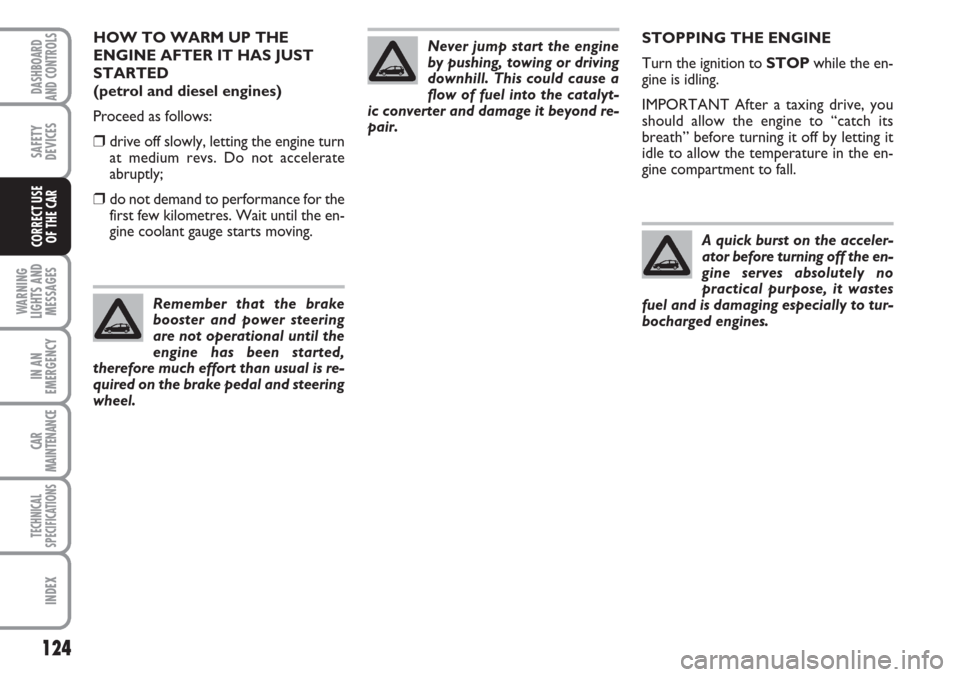
124
WARNING
LIGHTS AND
MESSAGES
IN AN
EMERGENCY
CAR
MAINTENANCE
TECHNICAL
SPECIFICATIONS
INDEX
DASHBOARD
AND CONTROLS
SAFETY
DEVICES
CORRECT USE
OF THE CAR
STOPPING THE ENGINE
Turn the ignition to STOPwhile the en-
gine is idling.
IMPORTANT After a taxing drive, you
should allow the engine to “catch its
breath” before turning it off by letting it
idle to allow the temperature in the en-
gine compartment to fall.
A quick burst on the acceler-
ator before turning off the en-
gine serves absolutely no
practical purpose, it wastes
fuel and is damaging especially to tur-
bocharged engines.HOW TO WARM UP THE
ENGINE AFTER IT HAS JUST
STARTED
(petrol and diesel engines)
Proceed as follows:
❒drive off slowly, letting the engine turn
at medium revs. Do not accelerate
abruptly;
❒do not demand to performance for the
first few kilometres. Wait until the en-
gine coolant gauge starts moving.
Remember that the brake
booster and power steering
are not operational until the
engine has been started,
therefore much effort than usual is re-
quired on the brake pedal and steering
wheel.
Never jump start the engine
by pushing, towing or driving
downhill. This could cause a
flow of fuel into the catalyt-
ic converter and damage it beyond re-
pair.
Page 128 of 230
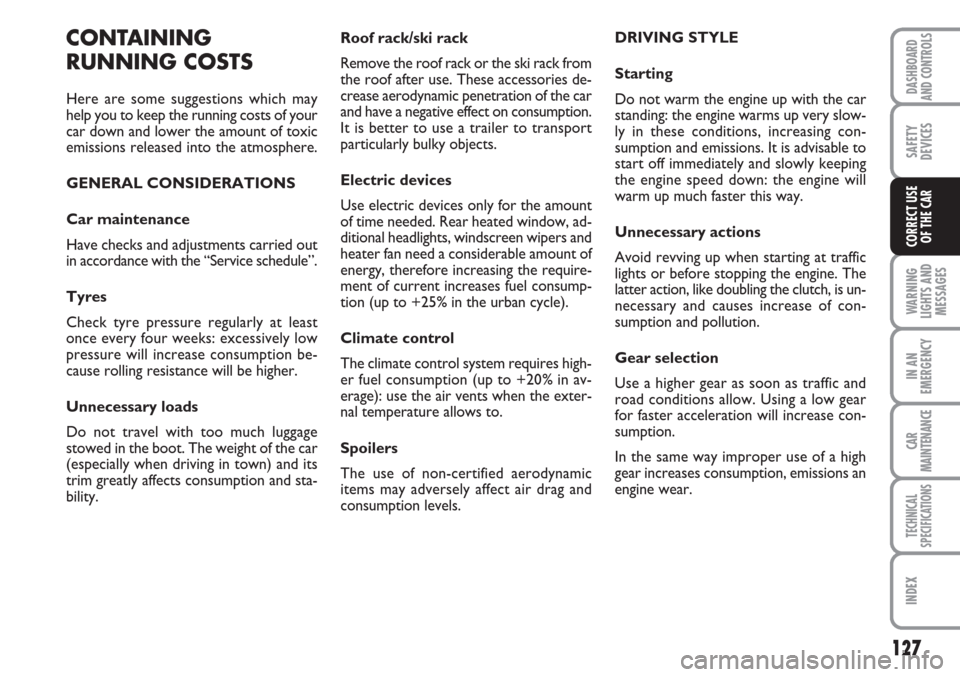
127
WARNING
LIGHTS AND
MESSAGES
IN AN
EMERGENCY
CAR
MAINTENANCE
TECHNICAL
SPECIFICATIONS
INDEX
DASHBOARD
AND CONTROLS
SAFETY
DEVICES
CORRECT USE
OF THE CAR
Roof rack/ski rack
Remove the roof rack or the ski rack from
the roof after use. These accessories de-
crease aerodynamic penetration of the car
and have a negative effect on consumption.
It is better to use a trailer to transport
particularly bulky objects.
Electric devices
Use electric devices only for the amount
of time needed. Rear heated window, ad-
ditional headlights, windscreen wipers and
heater fan need a considerable amount of
energy, therefore increasing the require-
ment of current increases fuel consump-
tion (up to +25% in the urban cycle).
Climate control
The climate control system requires high-
er fuel consumption (up to +20% in av-
erage): use the air vents when the exter-
nal temperature allows to.
Spoilers
The use of non-certified aerodynamic
items may adversely affect air drag and
consumption levels.DRIVING STYLE
Starting
Do not warm the engine up with the car
standing: the engine warms up very slow-
ly in these conditions, increasing con-
sumption and emissions. It is advisable to
start off immediately and slowly keeping
the engine speed down: the engine will
warm up much faster this way.
Unnecessary actions
Avoid revving up when starting at traffic
lights or before stopping the engine. The
latter action, like doubling the clutch, is un-
necessary and causes increase of con-
sumption and pollution.
Gear selection
Use a higher gear as soon as traffic and
road conditions allow. Using a low gear
for faster acceleration will increase con-
sumption.
In the same way improper use of a high
gear increases consumption, emissions an
engine wear.CONTAINING
RUNNING COSTS
Here are some suggestions which may
help you to keep the running costs of your
car down and lower the amount of toxic
emissions released into the atmosphere.
GENERAL CONSIDERATIONS
Car maintenance
Have checks and adjustments carried out
in accordance with the “Service schedule”.
Tyres
Check tyre pressure regularly at least
once every four weeks: excessively low
pressure will increase consumption be-
cause rolling resistance will be higher.
Unnecessary loads
Do not travel with too much luggage
stowed in the boot. The weight of the car
(especially when driving in town) and its
trim greatly affects consumption and sta-
bility.
Page 136 of 230
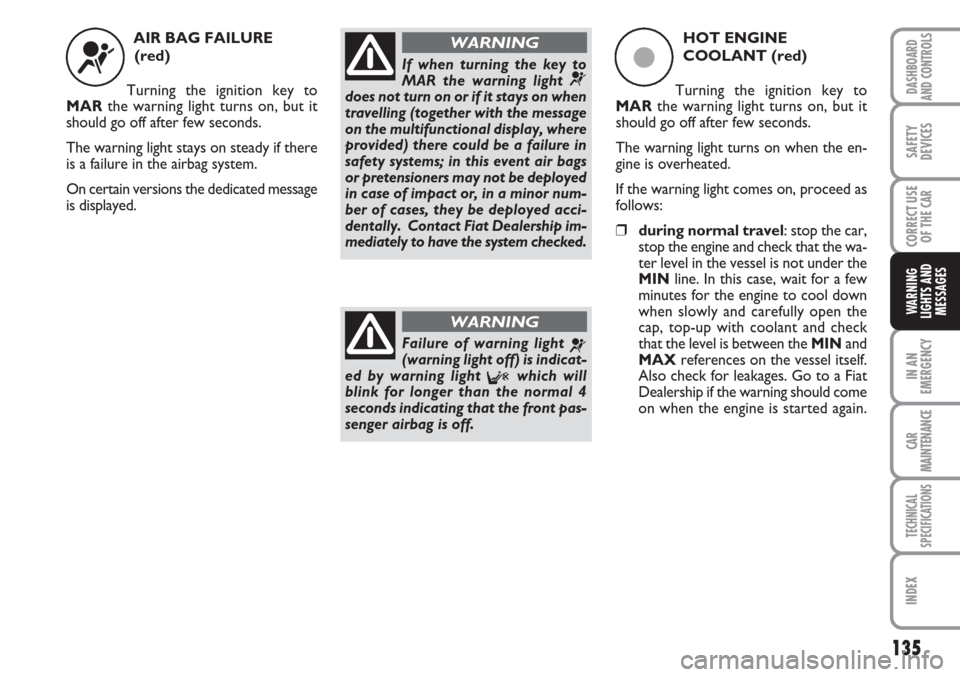
135
IN AN
EMERGENCY
CAR
MAINTENANCE
TECHNICAL
SPECIFICATIONS
INDEX
DASHBOARD
AND CONTROLS
SAFETY
DEVICES
CORRECT USE
OF THE
CAR
WARNING
LIGHTS AND
MESSAGES
AIR BAG FAILURE
(red)
Turning the ignition key to
MARthe warning light turns on, but it
should go off after few seconds.
The warning light stays on steady if there
is a failure in the airbag system.
On certain versions the dedicated message
is displayed.
¬If when turning the key to
MAR the warning light ¬does not turn on or if it stays on when
travelling (together with the message
on the multifunctional display, where
provided) there could be a failure in
safety systems; in this event air bags
or pretensioners may not be deployed
in case of impact or, in a minor num-
ber of cases, they be deployed acci-
dentally. Contact Fiat Dealership im-
mediately to have the system checked.
WARNING
Failure of warning light ¬(warning light off) is indicat-
ed by warning light
Fwhich will
blink for longer than the normal 4
seconds indicating that the front pas-
senger airbag is off.
WARNING
HOT ENGINE
COOLANT (red)
Turning the ignition key to
MARthe warning light turns on, but it
should go off after few seconds.
The warning light turns on when the en-
gine is overheated.
If the warning light comes on, proceed as
follows:
❒during normal travel: stop the car,
stop the engine and check that the wa-
ter level in the vessel is not under the
MINline. In this case, wait for a few
minutes for the engine to cool down
when slowly and carefully open the
cap, top-up with coolant and check
that the level is between the MINand
MAXreferences on the vessel itself.
Also check for leakages. Go to a Fiat
Dealership if the warning should come
on when the engine is started again.
ç
Page 137 of 230
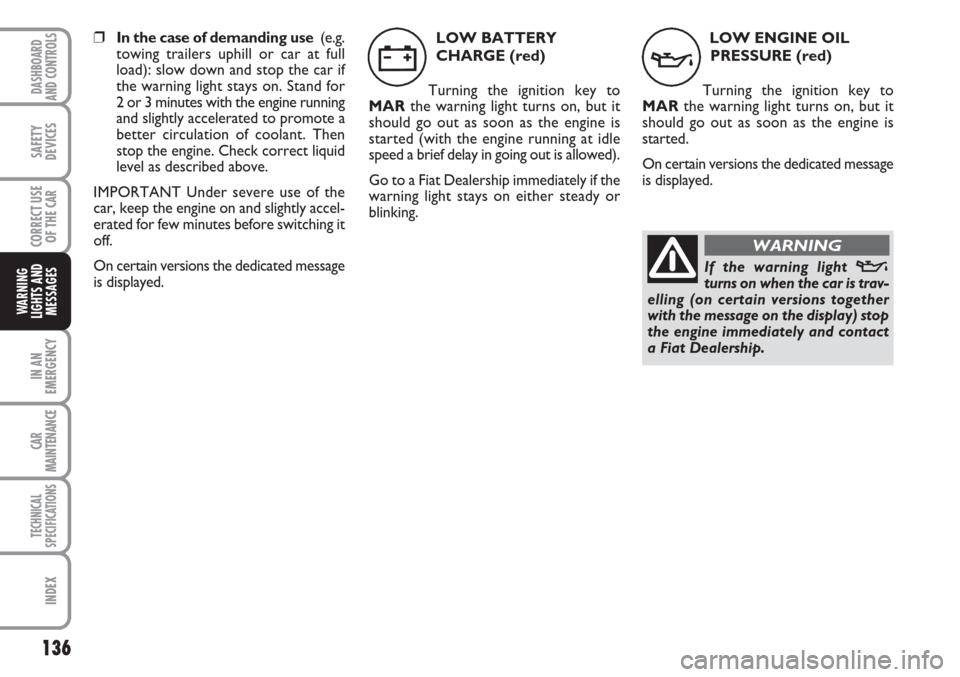
136
IN AN
EMERGENCY
CAR
MAINTENANCE
TECHNICAL
SPECIFICATIONS
INDEX
DASHBOARD
AND CONTROLS
SAFETY
DEVICES
CORRECT USE
OF THE
CAR
WARNING
LIGHTS AND
MESSAGES
LOW ENGINE OIL
PRESSURE (red)
Turning the ignition key to
MARthe warning light turns on, but it
should go out as soon as the engine is
started.
On certain versions the dedicated message
is displayed.
v
If the warning light vturns on when the car is trav-
elling (on certain versions together
with the message on the display) stop
the engine immediately and contact
a Fiat Dealership.
WARNING
❒In the case of demanding use (e.g.
towing trailers uphill or car at full
load): slow down and stop the car if
the warning light stays on. Stand for
2 or 3 minutes with the engine running
and slightly accelerated to promote a
better circulation of coolant. Then
stop the engine. Check correct liquid
level as described above.
IMPORTANT Under severe use of the
car, keep the engine on and slightly accel-
erated for few minutes before switching it
off.
On certain versions the dedicated message
is displayed.LOW BATTERY
CHARGE (red)
Turning the ignition key to
MARthe warning light turns on, but it
should go out as soon as the engine is
started (with the engine running at idle
speed a brief delay in going out is allowed).
Go to a Fiat Dealership immediately if the
warning light stays on either steady or
blinking.
w
Page 139 of 230
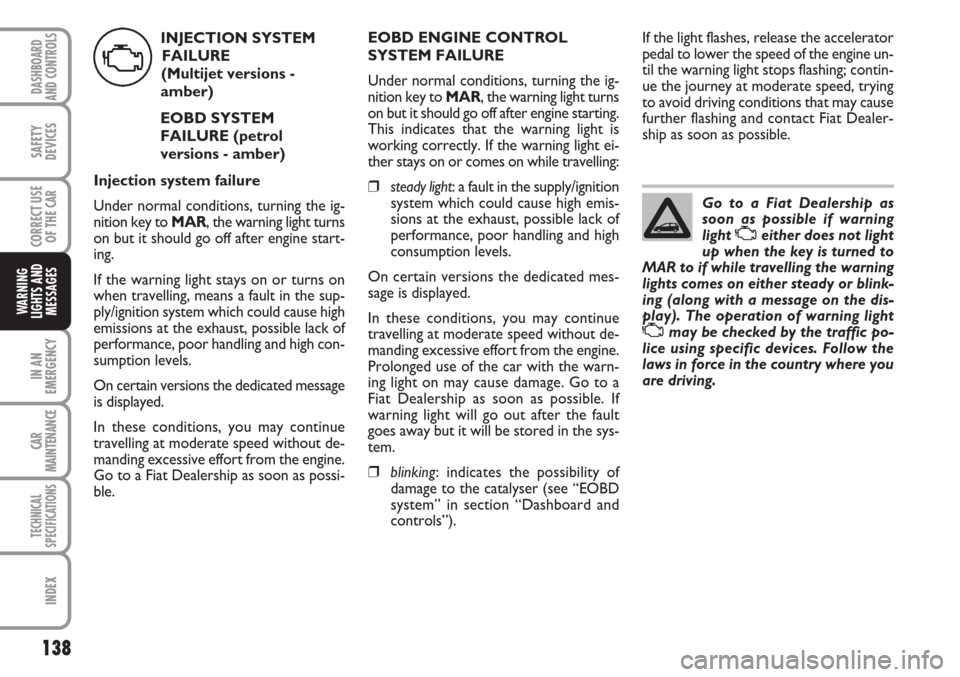
138
IN AN
EMERGENCY
CAR
MAINTENANCE
TECHNICAL
SPECIFICATIONS
INDEX
DASHBOARD
AND CONTROLS
SAFETY
DEVICES
CORRECT USE
OF THE
CAR
WARNING
LIGHTS AND
MESSAGES
Go to a Fiat Dealership as
soon as possible if warning
light
Ueither does not light
up when the key is turned to
MAR to if while travelling the warning
lights comes on either steady or blink-
ing (along with a message on the dis-
play). The operation of warning light
Umay be checked by the traffic po-
lice using specific devices. Follow the
laws in force in the country where you
are driving.
If the light flashes, release the accelerator
pedal to lower the speed of the engine un-
til the warning light stops flashing; contin-
ue the journey at moderate speed, trying
to avoid driving conditions that may cause
further flashing and contact Fiat Dealer-
ship as soon as possible. EOBD ENGINE CONTROL
SYSTEM FAILURE
Under normal conditions, turning the ig-
nition key to MAR, the warning light turns
on but it should go off after engine starting.
This indicates that the warning light is
working correctly. If the warning light ei-
ther stays on or comes on while travelling:
❒steady light: a fault in the supply/ignition
system which could cause high emis-
sions at the exhaust, possible lack of
performance, poor handling and high
consumption levels.
On certain versions the dedicated mes-
sage is displayed.
In these conditions, you may continue
travelling at moderate speed without de-
manding excessive effort from the engine.
Prolonged use of the car with the warn-
ing light on may cause damage. Go to a
Fiat Dealership as soon as possible. If
warning light will go out after the fault
goes away but it will be stored in the sys-
tem.
❒blinking: indicates the possibility of
damage to the catalyser (see “EOBD
system” in section “Dashboard and
controls”). INJECTION SYSTEM
FAILURE
(Multijet versions -
amber)
EOBD SYSTEM
FAILURE (petrol
versions - amber)
Injection system failure
Under normal conditions, turning the ig-
nition key to MAR, the warning light turns
on but it should go off after engine start-
ing.
If the warning light stays on or turns on
when travelling, means a fault in the sup-
ply/ignition system which could cause high
emissions at the exhaust, possible lack of
performance, poor handling and high con-
sumption levels.
On certain versions the dedicated message
is displayed.
In these conditions, you may continue
travelling at moderate speed without de-
manding excessive effort from the engine.
Go to a Fiat Dealership as soon as possi-
ble.
U
Page 141 of 230
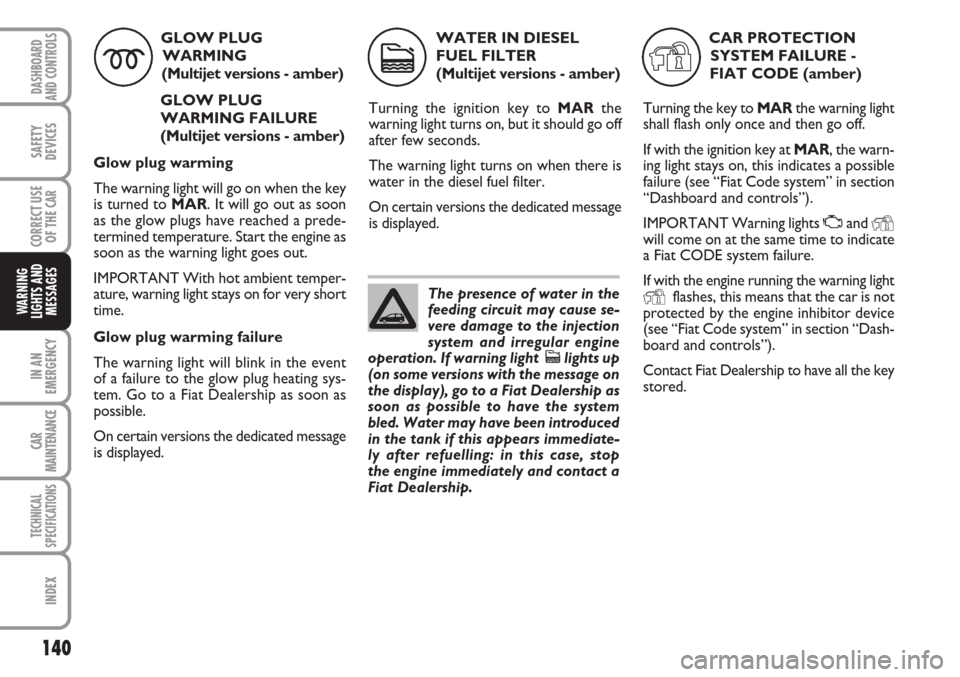
140
IN AN
EMERGENCY
CAR
MAINTENANCE
TECHNICAL
SPECIFICATIONS
INDEX
DASHBOARD
AND CONTROLS
SAFETY
DEVICES
CORRECT USE
OF THE
CAR
WARNING
LIGHTS AND
MESSAGES
GLOW PLUG
WARMING
(Multijet versions - amber)
GLOW PLUG
WARMING FAILURE
(Multijet versions - amber)
Glow plug warming
The warning light will go on when the key
is turned to MAR. It will go out as soon
as the glow plugs have reached a prede-
termined temperature. Start the engine as
soon as the warning light goes out.
IMPORTANT With hot ambient temper-
ature, warning light stays on for very short
time.
Glow plug warming failure
The warning light will blink in the event
of a failure to the glow plug heating sys-
tem. Go to a Fiat Dealership as soon as
possible.
On certain versions the dedicated message
is displayed.
m
WATER IN DIESEL
FUEL FILTER
(Multijet versions - amber)
Turning the ignition key to MARthe
warning light turns on, but it should go off
after few seconds.
The warning light turns on when there is
water in the diesel fuel filter.
On certain versions the dedicated message
is displayed.
c
The presence of water in the
feeding circuit may cause se-
vere damage to the injection
system and irregular engine
operation. If warning light
clights up
(on some versions with the message on
the display), go to a Fiat Dealership as
soon as possible to have the system
bled. Water may have been introduced
in the tank if this appears immediate-
ly after refuelling: in this case, stop
the engine immediately and contact a
Fiat Dealership.
CAR PROTECTION
SYSTEM FAILURE -
FIAT CODE (amber)
Turning the key to MARthe warning light
shall flash only once and then go off.
If with the ignition key at MAR, the warn-
ing light stays on, this indicates a possible
failure (see “Fiat Code system” in section
“Dashboard and controls”).
IMPORTANT Warning lights
Uand Ywill come on at the same time to indicate
a Fiat CODE system failure.
If with the engine running the warning light
Yflashes, this means that the car is not
protected by the engine inhibitor device
(see “Fiat Code system” in section “Dash-
board and controls”).
Contact Fiat Dealership to have all the key
stored.
Y
Page 157 of 230
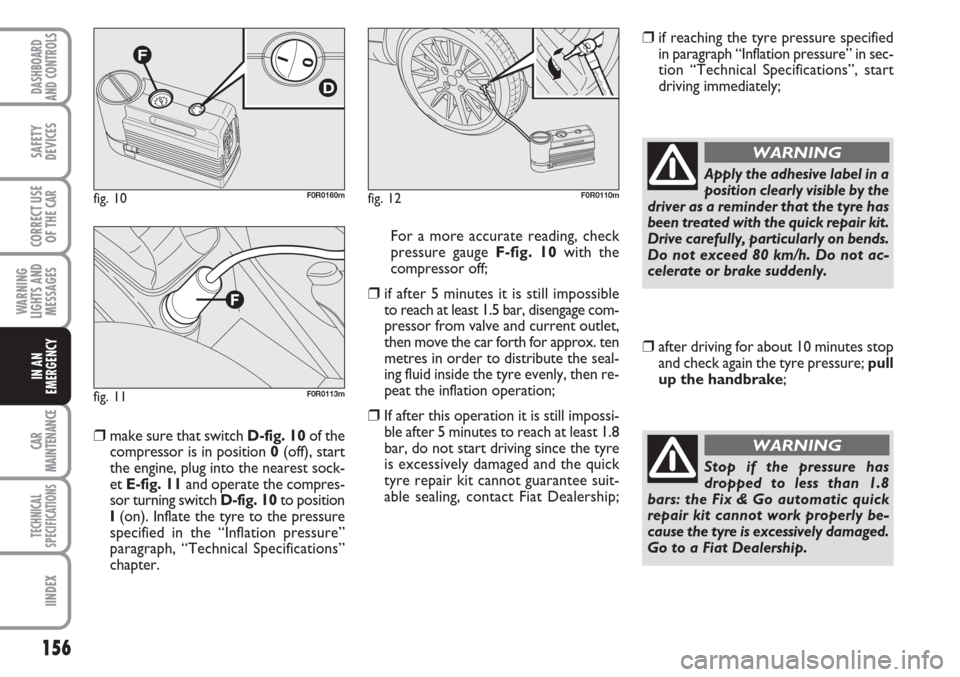
156
WARNING
LIGHTS AND
MESSAGES
CAR
MAINTENANCE
TECHNICAL
SPECIFICATIONS
IINDEX
DASHBOARD
AND CONTROLS
SAFETY
DEVICES
CORRECT USE
OF THE
CAR
IN AN
EMERGENCY
❒make sure that switch D-fig. 10of the
compressor is in position 0(off), start
the engine, plug into the nearest sock-
et E-fig. 11and operate the compres-
sor turning switch D-fig. 10to position
I(on). Inflate the tyre to the pressure
specified in the “Inflation pressure”
paragraph, “Technical Specifications”
chapter. For a more accurate reading, check
pressure gauge F-fig. 10with the
compressor off;
❒if after 5 minutes it is still impossible
to reach at least 1.5 bar, disengage com-
pressor from valve and current outlet,
then move the car forth for approx. ten
metres in order to distribute the seal-
ing fluid inside the tyre evenly, then re-
peat the inflation operation;
❒If after this operation it is still impossi-
ble after 5 minutes to reach at least 1.8
bar, do not start driving since the tyre
is excessively damaged and the quick
tyre repair kit cannot guarantee suit-
able sealing, contact Fiat Dealership;
❒if reaching the tyre pressure specified
in paragraph “Inflation pressure” in sec-
tion “Technical Specifications”, start
driving immediately;
fig. 10F0R0160m
fig. 11F0R0113m
fig. 12F0R0110m
Apply the adhesive label in a
position clearly visible by the
driver as a reminder that the tyre has
been treated with the quick repair kit.
Drive carefully, particularly on bends.
Do not exceed 80 km/h. Do not ac-
celerate or brake suddenly.
WARNING
❒after driving for about 10 minutes stop
and check again the tyre pressure; pull
up the handbrake;
Stop if the pressure has
dropped to less than 1.8
bars: the Fix & Go automatic quick
repair kit cannot work properly be-
cause the tyre is excessively damaged.
Go to a Fiat Dealership.
WARNING
Page 187 of 230
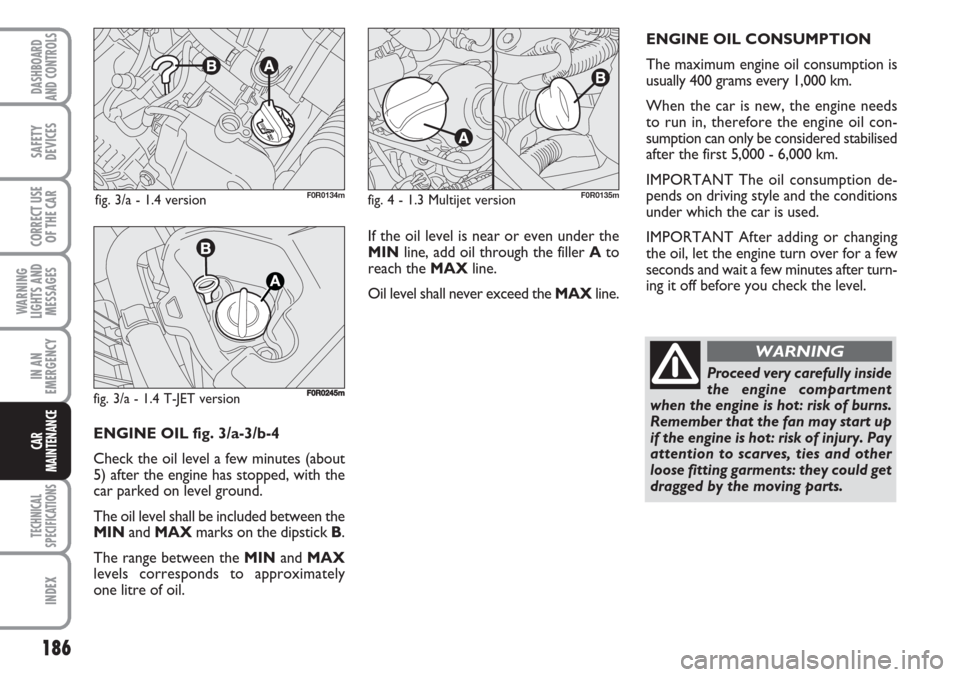
186
WARNING
LIGHTS AND
MESSAGES
TECHNICAL
SPECIFICATIONS
INDEX
DASHBOARD
AND CONTROLS
SAFETY
DEVICES
CORRECT USE
OF THE CAR
IN AN
EMERGENCY
CAR
MAINTENANCE
If the oil level is near or even under the
MINline, add oil through the filler Ato
reach the MAXline.
Oil level shall never exceed the MAXline.ENGINE OIL CONSUMPTION
The maximum engine oil consumption is
usually 400 grams every 1,000 km.
When the car is new, the engine needs
to run in, therefore the engine oil con-
sumption can only be considered stabilised
after the first 5,000 - 6,000 km.
IMPORTANT The oil consumption de-
pends on driving style and the conditions
under which the car is used.
IMPORTANT After adding or changing
the oil, let the engine turn over for a few
seconds and wait a few minutes after turn-
ing it off before you check the level.
ENGINE OIL fig. 3/a-3/b-4
Check the oil level a few minutes (about
5) after the engine has stopped, with the
car parked on level ground.
The oil level shall be included between the
MINand MAXmarks on the dipstick B.
The range between the MINand MAX
levels corresponds to approximately
one litre of oil.
fig. 3/a - 1.4 version F0R0134mfig. 4 - 1.3 Multijet versionF0R0135m
Proceed very carefully inside
the engine compartment
when the engine is hot: risk of burns.
Remember that the fan may start up
if the engine is hot: risk of injury. Pay
attention to scarves, ties and other
loose fitting garments: they could get
dragged by the moving parts.
WARNING
fig. 3/a - 1.4 T-JET versionF0R0245m